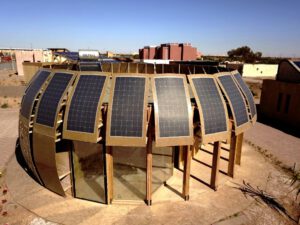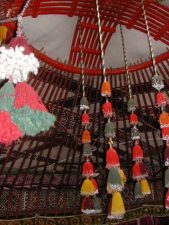 My Berber guide Mohammed on our return journey from Mt. Toubkal, North Africa’s highest point.
My Berber guide Mohammed on our return journey from Mt. Toubkal, North Africa’s highest point.
“You should know that I haven’t hiked in a while,” I told Mohammed, my Berber guide for a two day trek to the highest point in North Africa. He nodded and grinned, understanding nary a word. I allowed myself to feel reassured knowing full well that he should have said, “lady – go hike a few smaller trails and then come back.” Instead, we set out at 9am the following morning for our 14 mile, 7, 826 foot climb from Imlil, a small village in the nook of the Atlas Mountains south of Marrakech, to Mt. Toubkal – the top of the range.
 Maybe this isn’t such a good idea?
Maybe this isn’t such a good idea?
In my former incarnation as a tour leader, the hike to Toubkal, which in Tamazight literally means the highest point of the region, would have been a breeze (except for the altitude, which effects even the most seasoned hiker.) As a sedentary freelance writer afraid to leave the computer for more than a few minutes, going up went remarkably well. Coming back, not so much.
The owners of my gîte, Azdour Abdellali, arranged everything. They waited late Friday evening for the taxi to drop me off in Imlil, had tea waiting for me in their three-storey home (with a terrace that boasts some of the best views imaginable), served a delicious tagine for dinner, fed me again in the morning, arranged my guide, and essentially made sure that I was taken care of from start to grueling finish.Immediately after leaving the gîte, the climb began, first on to a cleared dirt road and through another Berber village just above Imlil, and then to the rocky banks of the Mizane River.
From there we began to make serious elevation changes that left me not breathless, but dizzy. Dizzy enough to stay away from the edge. Mules and pilgrims
Mules and pilgrims
Making way for hardworking mules arranged with colorful baskets carrying tents, backpacks, and other camping gear, or supplies for the various pitstops along the route, Mohammed and I made our way through the valley to Sidi Chamarouch in good time. He kept a cigarette dangling from his lips up and down the summit (and to my silent dismay, flicked the butts).
Like weary travelers trekking to greener pastures, we stopped at shops along the way that sold junk food, apparel, jewels, and bottled beverages kept cool by a “Berber refrigerator.” These were wonderful opportunities to have conversation with the men who tended them and ensured that we were rested before continuing on.
One young man worked as a translator for Peace Corps volunteers and explained how a half Thai student left his post early because he couldn’t get along with the group (gossip happens everywhere!) His penchant for language is not unusual, however. Most of the Berbers we met are remarkably adept at languages: many speak Arabic, English, French, Spanish, and Tamazight. Altitude adjustment
Altitude adjustment
It wasn’t long before we hit the morraine’s rocky green and pink slopes, where a real, live Berber shepherd tended his flock of sheep, and then the Refuge Toubkal established by the French Alpine Club as a base camp. We rested here for the night in order to adjust to the noticeable change in altitude.
At least 80 people were gathered at the Refuge, including several bright Moroccan university students, two pink-faced Scottish families, hardcore French and Spanish trekkers, a beautiful German family that belong on an advertisement for Swiss chocolate, and of course the many local people who kept this operation running as smooth as can be expected.
We left the following morning at 5.30am to ensure that we would have a clear vista at the summit. My guide illuminated our way across a plank bridge, under which the Mazine river gushed angrily, using a cell phone light. And then we hit the scree and boulders and a few precipitous edges. On one particularly steep ledge, my legs already exhausted of power, I sucked face with snowpack while the guide led me to the other end.  Surreal summit
Surreal summit
The summit can only be described as surreal. After several “what the hell am I doing moments,” and a final frightening push, we were at the top of North Africa, marked by a large “iron triangle” placed there in 1923 by Marquis de Segonzac, Vincent Berger and Hubert Dolbeau. Arriving was full of clean air and crystal perspective, and I genuinely feel renewed, but I would be Herodotus if I didn’t also explain how the sexy German hiker looked at me with unbridled pity and told me to trust my guide on the way back down. He must have noticed the apprehension written on my face that I thought was a silent struggle.
With several hours of hiking ahead of us, Mohammed and I set off. Going down was not only more difficult because of gravity and loose scree, but constantly stepping down is very hard on the knees – especially if, like me, your leg muscles have been neglected. I wished for hiking sticks, and towards the end, prayed for flat ground. But because it was worth it and because I had no other choice, I persevered. Perseverance conquers was my high school motto after all.
- You can take a shared taxi from Marrakech south to the Toubkal area. The journey to Imlil, a good starting point, takes roughly 1.5 hours depending on construction traffic and costs less than $10 if you have decent haggling skills.
- Azdour Abdellali did a fantastic job of arranging my trip. He can be reached at [email protected]. His relative Hossein (they call each other brothers but their relationship is more complicated than that) is a certified mountain guide and exceedingly professional. He can be reached at www.trekinmorocco.com.
- It is possible, with printed guides and maps and the right equipment, for the independent or budget traveler to do this trip alone during the summer months. However, having a Berber guide, and in some cases a mule, enhances the experience and bolsters the local economy.
- Take warm layers, good shoes, a water bottle and purification tablets if you don’t want to use a bunch of plastic bottles, a head lamp for the second morning departure, and plenty of sunscreen. The sun is hot hot hot on high.
all images by Tafline Laylin
More on travel, nature, and Morocco:
10 Tips for Traveling Like a Millionaire Without Stuff
Morocco and Egypt Eye Eco-Tourism Markets
Dare Eat Nuts Broken by a Goat’s Butt?



![Amazing “Atlas” tracks Arab world habitat destruction over time [video] Amazing “Atlas” tracks Arab world habitat destruction over time [video]](https://www.greenprophet.com/wp-content/uploads/coastal-development-united-arab-emirates-370x198.png)
